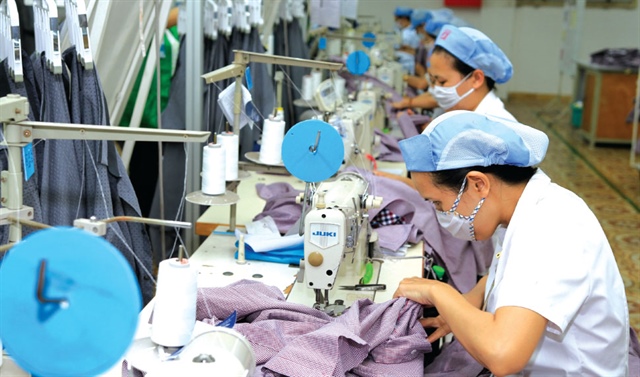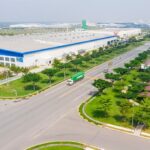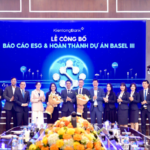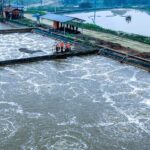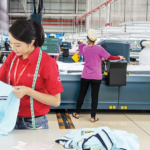
Vietnam’s textile and garment industry remains one of the country’s four key export sectors. Photo: T.L |
Risks and Challenges
The textile and garment industry is still one of Vietnam’s four main export sectors, contributing over 12% of the country’s total export turnover (after electronics, machinery equipment, and telephones). However, the industry is facing dual risks.
In terms of output, the US is the largest and most production-oriented market for Vietnamese textile and garment businesses. The challenge lies in the fact that the US is a demanding market, frequently changing policies on tariffs, traceability, forced labor, and recently, conditions related to ESG (environmental, social, and governance) factors. These changes can be disruptive to the industry if not prepared for in a timely manner.
On the input side, currently, more than 60% of textile and garment raw materials are imported from China. This makes the industry vulnerable to supply disruptions (as seen during the COVID-19 pandemic or in the event of China tightening its exports). We may also face risks related to certificates of origin (CO) when participating in free trade agreements (FTAs) such as the EVFTA or CPTPP, which require the use of intra-bloc or clearly-sourced raw materials.
The prolonged trade war has led the US to tighten its trade policies with China, while shifting orders to third countries, including Vietnam, providing short-term benefits to the Vietnamese textile and garment industry. However, Vietnam may also be affected if Vietnamese goods are suspected of “origin laundering” from China or using raw materials from Xinjiang, a region from which the US has banned imports of many products.
Meanwhile, regional competition is growing, particularly from Bangladesh, India, and Indonesia, countries with low labor costs that are heavily investing in their raw material supply chains. Production costs in Vietnam are rising, especially labor and logistics costs, leading to shrinking profit margins if the value chain is not restructured.
Thus, the current situation of Vietnam’s textile and garment industry presents both opportunities and deep vulnerabilities if strategic changes are not made. Therefore, Vietnam needs to leverage its advantages in geographical location, skilled labor, and FTAs to attract more long-term orders from global brands that are moving away from China. At the same time, Vietnam also needs to reduce its dependence on Chinese raw materials, invest in supporting industries, and transition to green and sustainable practices to adapt to new trends in the international market, especially in the US and Europe.
The Textile and Garment Industry Needs Friend-Shoring
In the context of rapidly changing global trade and geopolitical instability, Vietnam can and should become a strategic link in the global friendly textile supply chain.
First, Vietnam is presented with a significant opportunity arising from the trend of establishing safe supply chains with friendly countries – friend-shoring. This strategy is being pursued by the US and other developed nations to reduce risks from unstable or non-transparent markets. Vietnam, with its stable geopolitical position, open trade policies, and strong textile industry foundation, is well-positioned to replace a portion of China’s supply role in the eyes of international brands.
Second, to truly become an important and sustainable link in the global supply chain, Vietnam needs to move beyond its traditional role as a manufacturer and engage more deeply in higher value-added stages, such as design, product development, brand building, and especially, striving to meet ESG standards, which are increasingly mandatory for major labels in the US, Europe, and Japan.
Given the intertwined opportunities and challenges, to proactively establish networks and become a critical link, businesses need to implement the following:
(1) Diversify raw material sources by proactively seeking partners from India, South Korea, Japan, or ASEAN countries. In the long run, the state must work with businesses to invest in developing domestic supporting industries to ensure raw material self-sufficiency.
(2) Invest in technology to improve productivity and quality: Digital transformation and production modernization not only enhance productivity but are also necessary for product traceability, emission reduction, and compliance with the increasingly stringent ESG requirements of international partners.
(3) The state should develop mechanisms to encourage the formation of chains: For each newly formed textile chain (fiber – yarn – dyeing, finishing – garment), the government should consider incentive mechanisms for each chain to prove its linkage effectiveness through chain sales, sales of products used by each other, and export sales. The incentive mechanism can be implemented through land rent support, corporate income tax exemption or reduction, import tax and value-added tax deduction, or through the provision of credit with preferential interest rates.
(4) The state needs to continue promoting policies to enhance Vietnam’s friendliness in the eyes of foreign partners, such as: Vietnam wants to be friends with all countries, Vietnam has a stable political environment and supports foreign investors when they do business in accordance with Vietnamese law… Continue to promote the negotiation of new-generation FTAs, prepare higher-quality human resources, and create a favorable business environment to attract foreign investors and partners.
Khanh Nguyen
– 07:00 06/03/2025
The Evolution of Vietnam’s Industrial Zones: Positioning for the ESG and Digital Transformation Era
The Vietnam Industrial Park Development Forum 2025 focuses on pivotal topics such as sustainable industrial park development orientations for the 2025–2030 period, promoting infrastructure investment linked to socio-economic development, and establishing eco-friendly and smart industrial park models.
KienlongBank: Leading the Way with the Dual Implementation of Basel III and ESG Projects
“With the synchronous implementation of both the Basel III and ESG projects, KienlongBank is demonstrating its strong commitment to enhancing its risk management capabilities and resilience against unforeseen fluctuations. This dual initiative underscores the bank’s proactive approach to not only meet but exceed regulatory standards, solidifying its foundation for sustainable growth.”
Masan High-Tech Materials: Honored as a “Sustainable Enterprise” for Seven Consecutive Years
On November 29, Masan High-Tech Materials, a leading provider of advanced materials, was once again recognized for its sustainability efforts, securing a place in the prestigious Top 100 Sustainable Businesses in Vietnam (CSI 100). This acknowledgment underscores the company’s unwavering commitment to environmental stewardship, social responsibility, and strong governance practices.
The Textile Industry Confronts the European Green Deal
Although the EU’s green policies present significant challenges for Vietnam’s textile exports, in the long run, proactively embracing a comprehensive and synchronized green transition can unlock opportunities for businesses.

